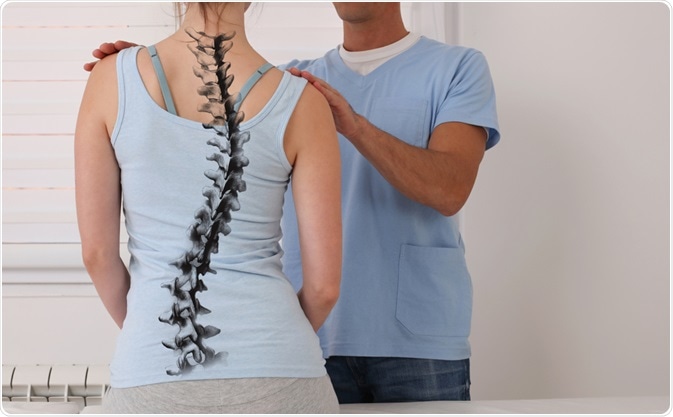There are several important factors that should be considered when investigating the probability that an individual is experiencing signs or symptoms of scoliosis. Questions should be asked about the medical history, family history, and presenting symptoms, followed by a physical exam and specific diagnostic tests.

Image Credit: Albina Gavrilovic / Shutterstock.com
Medical and family history
The first step to investigate the involvement of and diagnose scoliosis in a patient with presenting symptoms is to gather a sound medical and family history.
The medical history is important because there are certain factors and related health conditions, such as cerebral palsy and spinal muscular atrophy, that may influence the diagnosis. Additionally, it can help to differentiate scoliosis from other related health conditions.
The family history is helpful because individuals with other members in their family that are affected by scoliosis are more likely to suffer from the condition. Although a clear genetic link is yet to be established, questioning about family members with the condition can be useful.
If scoliosis is suspected, further questions should be asked on the patient’s growth spurts and patterns. This can help to evaluate the relevance of different treatments, as some are indicated before or during a child’s growth, whereas others are most effective for patients who have reached their adult height.
Presenting symptoms
The symptoms noted by someone with scoliosis may vary according to the individual; however, the following signs and symptoms may be indicative of the condition:
- Head not centered directly above the pelvis
- Asymmetrical ribcage, with ribs at different heights
- One shoulder blade more prominent than the other
- Asymmetrical hips, with one more prominent
- Leaning to one side
- One leg longer than the other
- Clothes that do not fit properly
Patients may also experience back pain, but this is not usually evident in young children and adolescents when the condition most commonly presents.
It can be useful to ask patients if these factors affect them because they may not have noticed subtle changes until directly asked.
Physical exam
The physical examination uses various techniques to assess the posture, stance, and movement of the individual and determine the likelihood of scoliosis.
While the patient is standing, the anterior, posterior, and lateral aspects should be inspected for signs of other health conditions. The symmetry of the body, particularly the shoulders, ribs, hips, and pelvis should then be considered, as well as the length of the legs.
If the patient is asked to walk, first on their toes and then on their heels, motor weaknesses in the muscle groups of the lower legs become evident. This is a useful indicative test that can help in the investigation of scoliosis.
Adams’ forward bend test, which involves viewing the patient as they bend forward at the waist, is helpful in the identification of paraspinal and rib prominences that result from abnormal vertebral rotation. This is considered to be the standard test that indicates the likelihood of scoliosis and patients with a positive test warrant further investigation.
A scoliometer is an instrument that can help to quantify asymmetries of the body that have been identified with other tests. More than 5° at either the thoracic or lumbar prominence is considered to be a positive result.
It is also useful to examine the hands and feet of the patient to investigate their proprioception and reflex function, both of which can provide information on the involvement of the spinal nerves.
Diagnostic tests
An X-ray is usually required to confirm a diagnosis of scoliosis, although it is recommended that the patient consult a spine specialist before getting an X-ray.
The Cobb angle measurement, which measures the angle between the upper and lowermost vertebrae is indicative of scoliosis for readings of 10° or more.
The current bone age and estimated remaining growth of the individual, both of which are important factors in the treatment of scoliosis, can be estimated with an iliac apophysis or the Risser sign test.
In some cases, magnetic resonance imaging (MRI) may be required to eliminate the possibility of other related health conditions, such as syringomyelia, Arnold-Chiari malformation, or a tumor, leading to the symptoms.
References
Further Reading